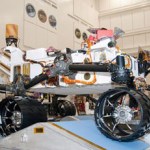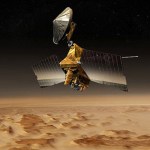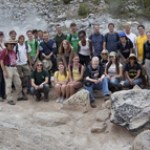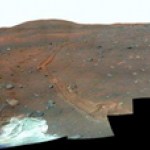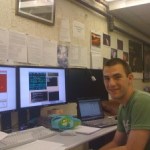
By Dr. Rosalba Bonaccorsi
Environmental Scientist at the Carl Sagan Center for the Study of Life in the Universe, SETI Institute, and Gail Jacobs
Rosalba, what first sparked your interest in science?
I've always had big dreams -- even as a young girl. As soon as I started to walk, I took an interest in conducting experiments with whatever was available around such as household plants and various chemical compounds. I'm lucky I didn't end up poisoned or otherwise hurt! I remember dismantling alarm clocks. I was so curious!
As a young girl, I was in poor health and as a result spent a lot of…
By Dr. Adrian Brown
Planetary physicist at the Carl Sagan Center for the Study of Life in the Universe, SETI Institute, and Gail Jacobs
When most people look at photos of the Martian landscape, they see the kind of dry topography that, while attractive, shows only that at first glance Mars resembles many of the desert areas of Earth. By analyzing spectroscopic data gathered by the Mars Reconnaissance Orbiter, however, SETI Institute planetary scientist Dr. Adrian Brown sees clues to where liquid water might once have puddled and pooled on the Red Planet, and possibly spawned life. Adrian is…
By Dr. Paul EstradaPlanetary physicist at the Carl Sagan Center for the Study of Life in the Universe, SETI Institute, and Gail Jacobs
If planets are a dime a dozen, moons are less than a penny each. There are at least 139 moons just within our own solar system. Most of these are the property of the gas giant planets beyond Mars. More than just a nice accompaniment to planets, moons may have habitats in which liquid water could ebb and flow - and possibly be a suitable home for life. Planetary physicist Dr. Paul Estrada investigates how moons around gas giants are formed -- an important…
By Dr. Mark R. Showalter
Planetary astronomer at the Carl Sagan Center for the Study of Life in the Universe, SETI Institute
It was just a few months ago that Stephen Hawking was making headlines with his bold assertion that extraterrestrial beings, if they exist, are best avoided. His argument was based in part upon the fact that the arrival of Christopher Columbus to the "New World" didn't work out so well for the Native Americans who were already here. However, upon closer inspection, Hawking's ideas fell apart. Even if nomadic tribes of ETs are really out there looking for a handy source…
Every summer, the SETI Institute hosts 15-20 college students from around the country as part of its Astrobiology Research Experience for Undergraduates (REU) internship program. The program, which is funded by the National Science Foundation and the NASA Astrobiology Institute, pairs each student with a research mentor at the SETI Institute. At the end of the 10-week internship, each student presents a talk and written report on their research project, and many students go on to present their work at professional conferences during the following academic year.
This year, our 19 REU interns…
By Dr. Adrian Brown
Planetary Research Scientist at the Carl Sagan Center for the Study of Life in the Universe, SETI Institute
The last two months have witnessed several extremely important events with respect to future Mars Exploration. The first two revolved around the rover "Spirit." The other two are a new mission to Mars and a possible road for humans to Mars.
"Spirit"
On June 3rd, the Mars Exploration Rover (MER) team published a stunning paper describing how the rover "Spirit," now immobile in the shifting sands of Gusev Crater, detected carbonate minerals in a rock called "Comanche…
Don Backer, an astrophysicist at the University of California, Berkeley who discovered the first millisecond pulsar, died on July 25. He was director of Berkeley's Radio Astronomy Laboratory and the Allen Telescope Array (ATA) in Hat Creek, California - a collection of 42 dishes that recently began scanning the sky and searching for extraterrestrial intelligence.
"Memories of a special moment with Don Backer"
By Jill Tarter
Don and I had only a few glancing interactions from the time we were engineering physics students at Cornell until one memorable day in 1982. On that day I pulled my…
By Dr. Franck Marchis
Planetary Astronomer at the Carl Sagan Center for the Study of Life in the Universe, SETI Institute
I mentioned in my previous post that we observed several known multiple asteroid systems during our last observing run with the W.M. Keck Observatory and its Adaptive Optics Systems. If you have been following my personal blogs and/or the scientific articles of our group (you are courageous...) you know this is the scientific topic which is taking most of my time recently. Today, as you can see if you explore our VOBAD database, we know 192 companions of asteroids. What I…
By Dr. Franck Marchis
Planetary Astronomer at the Carl Sagan Center for the Study of Life in the Universe, SETI Institute
I'd like to share the first of two blogs on observations of Io that we did using the Keck telescope and its Adaptive Optics (AO) system.
Similar to last year, my summer is busy with the REU (Research Experience for Undergraduates) students of the SETI Institute. I will write a specific post on two students who are working with me and their project in a few days.
I obtained telescope time at the end of June 2010 with the W.M. Keck II telescope and its Adaptive Optics system…
By Dr. Mark R. Showalter
Planetary Astronomer at the Carl Sagan Center for the Study of Life in the Universe, SETI Institute
In 1609, Galileo introduced to the world his new invention, the astronomical telescope. It opened up new opportunities to explore a territory that all prior generations had regarded as familiar--the night sky. In short order, he was making major discoveries. But the sky is very big and Galileo's telescope was very small. He had to choose his targets carefully.
In that context, Saturn was nothing special, the least of the known planets, just a bright point in a black…
By Dr. Cynthia Phillips
Planetary geologist at the Carl Sagan Center for the Study of Life in the Universe, SETI Institute
Jupiter's moon Europa could be the best place beyond the Earth to search for life. This small moon, about the size of Earth's Moon, is one of the Galilean moons first discovered 400 years ago by Galileo. The Galilean moons were the first objects observed to orbit another planet, and they revolutionized the way our solar system was understood.
Today, the moons of Jupiter are known to be a scientifically rich part of our solar system, and they are yielding a new revolution…
In a recent conversation with SETI Institute Trustee, Dr. Frank Drake, we discussed the last 50 years of SETI research. Watch as Frank, for the very first time, describes his experience when he believed he discovered a sign of intelligent life in the universe!
by Nathalie A. Cabrol
I realize how immodest the title of this first blog may sound and it is certainly not my intention to convince anybody that I will answer this question in the limited space allowed here or even in a lifetime. My hope is, instead, to stir thoughts and invite an exchange of diverse perspectives to make this a thread that we can all pull from time to time. It is an immense subject debated in an abundant literature, but discussing it is certainly not the exclusive privilege of those called explorers. All beings, from the greatest minds to the simplest forms of life on this…
